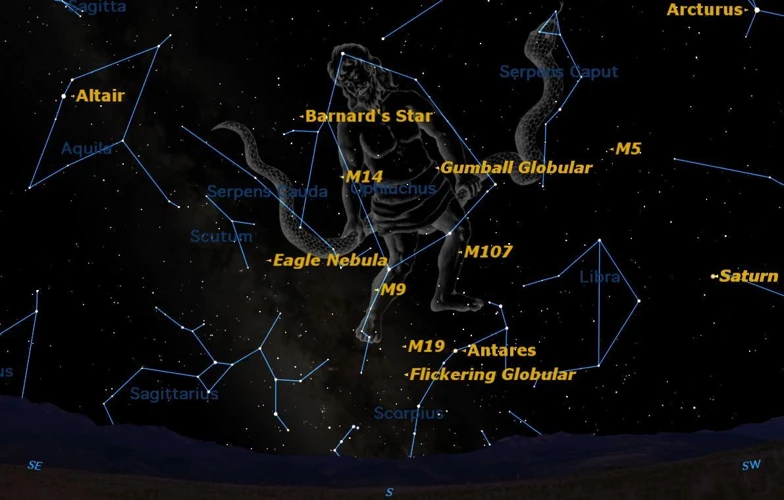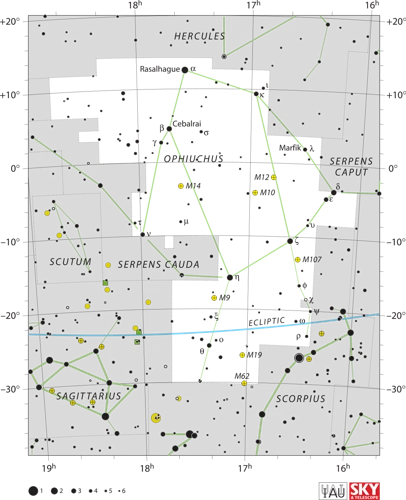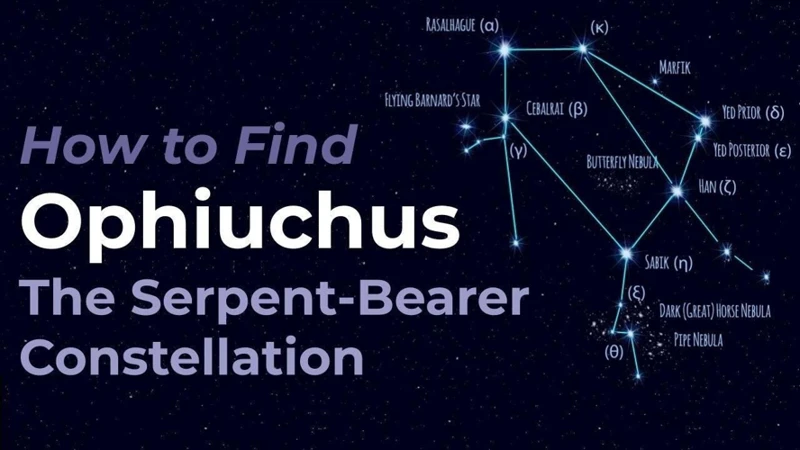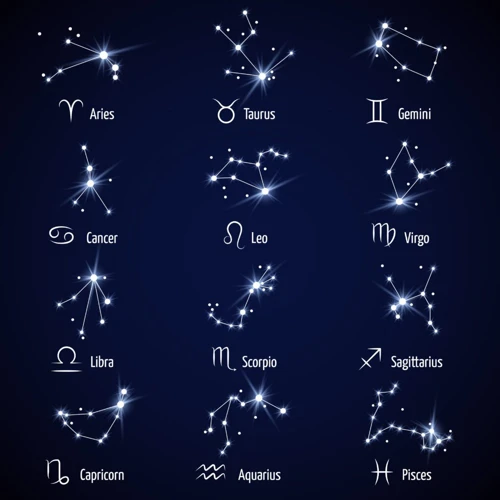The night sky has always fascinated and mesmerized humanity. One of the most captivating aspects of the night sky are the constellations – patterns of stars that have been recognized and studied for centuries. While the ancient constellations hold great historical and mythological significance, modern constellations offer a whole new level of wonder and discovery. But how can you identify these modern constellations in the vast expanse of the night sky? In this comprehensive guide, we will walk you through the step-by-step process of identifying modern constellations, from familiarizing yourself with the major constellations to connecting the dots and learning about the prominent bright stars. Whether you’re an amateur stargazer or a seasoned astronomer, this guide will equip you with the knowledge and techniques needed to explore the beautiful tapestry of the night sky with confidence and wonderment. So, grab your telescope or simply step outside on a clear night, as we embark on this celestial journey together.
Contents
- Understanding Modern Constellations
- Steps to Identifying Modern Constellations
- Tips for Easier Identification
- Common Modern Constellations
- Conclusion
-
Frequently Asked Questions
- 1. Can I see modern constellations from anywhere in the world?
- 2. Are modern constellations the same as ancient constellations?
- 3. How can I find modern constellations without a telescope?
- 4. Can I see modern constellations during the day?
- 5. Are modern constellations the same in the northern and southern hemispheres?
- 6. Are modern constellations fixed in the sky?
- 7. How many modern constellations are there?
- 8. Can I create my own modern constellation?
- 9. Can I identify modern constellations in urban areas with heavy light pollution?
- 10. Do some modern constellations change over time?
- References
-
Frequently Asked Questions
- 1. What is the significance of modern constellations?
- 2. How many modern constellations are there?
- 3. Can modern constellations be seen from anywhere on Earth?
- 4. Are modern constellations only visible at night?
- 5. How do modern constellations differ from traditional constellations?
- 6. Can modern constellations change over time?
- 7. What are the brightest stars in modern constellations?
- 8. How can star charts or mobile apps assist in identifying modern constellations?
- 9. What are some popular stellar patterns used to identify modern constellations?
- 10. How does light pollution affect the visibility of modern constellations?
- References
- Read More
Understanding Modern Constellations

Modern constellations are a relatively new addition to the celestial landscape, with the International Astronomical Union (IAU) officially recognizing and adopting them in the early 20th century. Unlike their ancient counterparts, which were based on mythological characters and stories, modern constellations are primarily based on scientific discoveries and observations. These constellations represent various objects, such as animals, scientific instruments, and even mythological figures from different cultures. For example, one of the most well-known modern constellations is Orion – The Hunter, which is named after the mythical Greek hunter. Another modern constellation, Cygnus – The Swan, represents a graceful bird in flight. Ursa Major – The Great Bear, which is part of the ancient zodiac constellations, is also included in the modern constellation list. Understanding modern constellations allows us to explore and appreciate the ever-expanding knowledge of our universe. By studying these constellations, we can deepen our understanding of scientific phenomena like neutron stars and their role in the cosmos. Each modern constellation carries its own unique significance and connects us to the vast wonders of our universe. One such constellation, Cassiopeia – The Queen, represents a queen from Greek mythology and can be easily identified by its distinctive ‘W’ or ‘M’ shape. Whether you are interested in mythology, astronomy, or simply appreciating the beauty of the night sky, understanding modern constellations opens up a world of knowledge and intrigue.
Steps to Identifying Modern Constellations

To successfully identify modern constellations in the night sky, follow these step-by-step guidelines. First, familiarize yourself with the major constellations, such as Orion – The Hunter, Ursa Major – The Great Bear, Cygnus – The Swan, and Cassiopeia – The Queen. Study their shapes and key stars. Second, learn about the zodiac constellations, including those that represent the twelve astrological signs. This knowledge will help you locate and identify them more easily. Third, identify the prominent bright stars in the sky. These stars act as guideposts and can lead you to the surrounding constellations. Connect these dots visually to trace the outline of the constellation. Finally, keep in mind that using a star chart or a mobile app can greatly assist in constellation identification and navigation. Consider factors such as the time of observation, as well as the potential effects of light pollution. By following these steps, you’ll be well on your way to confidently recognizing and appreciating the beauty of modern constellations and the stories they hold.
1. Familiarize Yourself with the Major Constellations
Familiarizing yourself with the major constellations is an essential first step in identifying modern constellations in the night sky. The major constellations are a group of well-known and easily recognizable patterns that have been passed down through generations. Some popular major constellations include Orion, Ursa Major, Cygnus, and Cassiopeia. Orion, known as The Hunter, is prominently visible during winter months and is characterized by three bright stars forming a belt, along with a distinctive line of stars representing his sword. Ursa Major, also known as The Great Bear, features the famous Big Dipper, which is part of the constellation’s overall shape. Cygnus, The Swan, is easily spotted due to its distinctive cross-like shape made up of several bright stars. Cassiopeia, or The Queen, is recognizable for its W or M shape and is easily visible in the northern night sky. By familiarizing yourself with these major constellations and their characteristic shapes, you will gain a solid foundation for recognizing and identifying other modern constellations. So, grab a sky map or use a mobile app to locate these major constellations, and let them guide your journey into the vastness of the night sky.
2. Learn About the Zodiac Constellations
Zodiac constellations hold a special place in the world of astrology and astronomy. There are twelve zodiac constellations that lie along the ecliptic, the apparent path of the Sun across the sky throughout the year. Each zodiac constellation represents a specific astrological sign and is closely associated with different personality traits and characteristics. To learn about the zodiac constellations, familiarize yourself with their names and the dates during which the Sun appears to pass through them. The twelve zodiac constellations are Aries, Taurus, Gemini, Cancer, Leo, Virgo, Libra, Scorpius, Sagittarius, Capricornus, Aquarius, and Pisces. A helpful way to remember them is through the mnemonic “The Ram (Aries), The Bull (Taurus), The Twins (Gemini), The Crab (Cancer), The Lion (Leo), The Virgin (Virgo), The Scales (Libra), The Scorpion (Scorpius), The Archer (Sagittarius), The Goat (Capricornus), The Water-Bearer (Aquarius), and The Fish (Pisces). Astrology enthusiasts often consult their rising sign, which is determined by the zodiac constellation that was on the horizon at their exact time of birth. Learning about the zodiac constellations adds a layer of meaning to stargazing and fosters a deeper appreciation for the connections between the celestial and human realms.
3. Identify the Prominent Bright Stars
Identifying the prominent bright stars is a crucial step in recognizing modern constellations. These stars act as guideposts, helping to form the patterns and shapes that define each constellation. To begin, familiarize yourself with some of the brightest stars in the night sky. One notable example is Sirius, also known as the Dog Star, which is part of the constellation Canis Major. Sirius shines with a brilliant white-blue light and is the brightest star visible from Earth. Another prominent star is Betelgeuse, a red supergiant located in the constellation Orion – The Hunter. Betelgeuse is known for its distinctive reddish-orange color and is one of the largest stars in our galaxy.
In addition to individual bright stars, it’s important to identify star patterns or asterisms within constellations. For instance, within the constellation Cygnus – The Swan, you can find the Northern Cross, a notable pattern formed by several bright stars. This asterism resembles a cross with Deneb marking the top, while other stars appear to form the crossbeam and arms. Recognizing these patterns greatly aids in identifying constellations and makes stargazing more enjoyable.
To assist in locating and learning about bright stars, you can utilize star charts or star finder mobile apps. These tools help you navigate the night sky by providing real-time information on the positions of stars and constellations. By identifying and familiarizing yourself with the prominent bright stars, you’ll gain a deeper understanding of the celestial world, enabling you to spot and appreciate the modern constellations above.
4. Connect the Dots
To identify modern constellations, one essential step is to connect the dots. Once you have familiarized yourself with the major and zodiac constellations and identified the prominent bright stars, it’s time to piece together the constellation patterns. Imagine the stars as dots on a canvas, waiting to be connected to form meaningful shapes. However, it’s important to note that constellations are not limited to the traditional stick-figure outlines we often see in books or illustrations. Instead, they are abstract patterns that represent various objects or figures. To connect the dots, start by locating the key stars that define the constellation’s shape. Look for distinct patterns or arrangements of stars that stand out from the surrounding sky. You can use a star chart or a mobile app to help guide you in this process. Once you have found the key stars, mentally trace a line connecting them, following the curve or angle that best matches the pattern. Remember, the lines connecting the stars may not be perfectly straight or symmetrical, so be open to the organic nature of the constellation’s shape. By connecting the dots, you bring the constellation to life, revealing its unique form against the backdrop of the night sky. It’s a rewarding and exciting experience to find the hidden shapes and unveil the stories they tell. So, grab your star map or download a mobile app, head outside on a clear night, and let your imagination guide you as you connect the celestial dots and uncover the modern constellations above.
Tips for Easier Identification

To make the identification of modern constellations in the night sky easier, there are several handy tips and tricks to keep in mind. Firstly, utilizing a star chart or a mobile app can assist in locating and identifying specific constellations accurately in real-time. These tools provide a visual representation of the night sky and can help navigate the vast number of stars and patterns. Secondly, looking for stellar patterns can aid in constellation identification. Many constellations form recognizable shapes or patterns, such as Orion’s belt or the Big Dipper. By identifying these patterns, it becomes simpler to locate and distinguish different constellations. Thirdly, observing during the right time is crucial. Certain constellations may only be visible during specific seasons or times of the year, so understanding their visibility windows can increase the chances of successful identification. Lastly, considering light pollution is important. Light pollution from urban areas can hinder visibility, so finding darker spots away from city lights greatly enhances the ability to spot and identify constellations. By following these tips for easier identification, anyone can embark on a journey of exploring modern constellations with greater ease and enjoyment.
1. Use a Star Chart or a Mobile App
Using a star chart or a mobile app is a helpful and convenient way to aid in identifying modern constellations. A star chart is a map of the night sky that shows the positions of stars, constellations, and other celestial objects. It can be a physical paper chart or a digital version that can be accessed online or through a mobile app. The advantage of using a star chart is that it provides a visual reference and allows you to compare the stars and constellations you observe with the chart. This helps you identify the modern constellations in relation to their neighboring stars. A mobile app specifically designed for stargazing can provide real-time information on the current position of constellations in the sky based on your location and time. Some apps even offer augmented reality features, allowing you to point your phone or tablet at the sky and see the names and outlines of modern constellations superimposed on the stars. These tools can be particularly useful for beginners or those who are not familiar with the night sky. With a star chart or a mobile app at your disposal, you can navigate the vastness of the night sky with confidence, enhancing your ability to identify and appreciate the beauty of modern constellations.
2. Look for Stellar Patterns
Looking for stellar patterns is a key technique for identifying modern constellations in the night sky. These patterns form the basis for identifying and distinguishing one constellation from another. Here are a few strategies to help you spot stellar patterns:
1. Connect the Dots: Constellations are made up of stars that, when connected, form recognizable shapes or patterns. These patterns may resemble objects or creatures. For example, the constellation Orion – The Hunter can be identified by its distinctive belt, formed by three bright stars in a straight line. Look for these connecting patterns to easily locate and identify constellations.
2. Use Star Maps: Star charts or maps can be incredibly helpful in identifying stellar patterns. These maps highlight the positions and patterns of stars in the night sky, making it easier to match them with the constellations you are trying to identify. You can find star charts online, in books, or through specialized stargazing apps for your mobile device.
3. Learn Common Patterns: Familiarize yourself with some of the common stellar patterns that appear in modern constellations. For example, the Big Dipper is a prominent pattern in Ursa Major – The Great Bear. It consists of seven bright stars that form a ladle or dipper shape. By recognizing and identifying these common patterns, you can quickly locate and understand the constellations they belong to.
4. Observe Contrast: Pay attention to the contrast between the dark night sky and the brighter stars. Stellar patterns are easier to spot against a dark background. Avoid areas with high light pollution, as they can make it more challenging to discern the patterns and identify constellations.
Remember that identifying stellar patterns takes practice and patience. Spend time observing the night sky, allowing your eyes to adjust to the darkness and the subtle details of the constellations. With time and experience, you will become more proficient at recognizing and appreciating the intricate stellar patterns that adorn our celestial sphere.
3. Observe During the Right Time
Observing the night sky during the right time is crucial for identifying modern constellations with clarity and precision. Here are some factors to consider:
1. **Seasonal Visibility:** Certain modern constellations are more visible during specific seasons. For example, Orion – The Hunter is most prominent during the winter months in the northern hemisphere. Ursa Major – The Great Bear is visible year-round but is particularly noticeable during the spring and summer. Understanding the seasonal visibility of modern constellations helps you plan your stargazing adventures accordingly.
2. **Moon Phase:** The phase of the moon can significantly impact your ability to observe stars and constellations. Bright moonlight can wash out the fainter stars, making it harder to spot constellations. Optimal viewing conditions occur during a new moon or a crescent moon phase when the sky is darker. Check a lunar calendar to find dates with minimal moonlight interference.
3. **Time of Night:** Different modern constellations are visible at different times of the night. It is best to observe during late evening or early morning hours when the sky is darker and fewer atmospheric disturbances are present. Plan your stargazing session accordingly, keeping in mind the rise and set times of the specific constellations you wish to observe.
4. **Location and Latitude:** Your geographical location plays a crucial role in determining the visibility of modern constellations. If you are in the northern hemisphere, certain constellations, such as Ursa Major, will be circumpolar, meaning they remain visible all year round. Conversely, constellations near the southern celestial pole may not be visible from higher latitudes in the northern hemisphere. Knowing your location and its corresponding impact on constellation visibility helps in planning your observations.
By considering these factors and observing during the right conditions, you greatly enhance your chances of successfully identifying and appreciating the beauty of modern constellations. Keep in mind that patience and persistence are key when embarking on a celestial journey, and allow yourself the opportunity to fully immerse in the wonders of the night sky.
4. Consider Light Pollution
Consider Light Pollution:
Light pollution can significantly impact your ability to identify modern constellations in the night sky. It occurs when excessive or misdirected artificial lighting brightens the atmosphere. Here are a few factors to consider when dealing with light pollution:
1. Urban vs. Rural Areas: In urban areas, the presence of streetlights, buildings, and other sources of light pollution can make it challenging to view stars and constellations. However, in rural areas with less artificial lighting, the night sky tends to be darker, providing better visibility.
2. The Moon’s Phase: The brightness of the moon can also affect your ability to see stars and constellations. During a full moon, its illumination can overpower the fainter stars and make them less visible. If possible, try planning your stargazing outing around the new moon phase when the sky is at its darkest.
3. Filters and Shields: To mitigate the effects of light pollution, consider using filters or shields to block out unwanted artificial light sources. There are various light pollution filters available that can enhance your stargazing experience by reducing the glare from streetlights and other bright sources.
4. Dark Sky Locations: Seek out dark sky locations that are relatively free from light pollution. These designated areas, such as national parks or observatories, prioritize preserving the natural darkness of the night sky. Visiting such places can provide optimal conditions for spotting modern constellations.
By taking light pollution into account, you can ensure a better stargazing experience and increase your chances of successfully identifying modern constellations. Remember, finding a location away from artificial lights and using appropriate tools can greatly enhance your ability to enjoy the beauty of the night sky.
Common Modern Constellations

Common modern constellations offer a wealth of celestial wonders to explore. Let’s take a closer look at some of these captivating constellations. One of the most recognizable modern constellations is Orion – The Hunter. Orion boasts a prominent belt of three bright stars and is home to several well-known features, including the Orion Nebula. Moving on, Ursa Major – The Great Bear is another popular modern constellation. Its distinctive shape, often referred to as the Big Dipper, makes it easy to spot in the night sky. Cygnus – The Swan, also known as the Northern Cross, is yet another notable modern constellation. Its shape outlines the graceful wings of a bird in flight. Lastly, Cassiopeia – The Queen captivates stargazers with its distinctive ‘W’ or ‘M’ shape and its inclusion in various mythologies. These are just a few examples of the enchanting common modern constellations that adorn our night sky, guiding us on a celestial journey of discovery and wonder.
1. Orion – The Hunter
Orion – The Hunter, is one of the most recognizable and prominent modern constellations in the night sky. It is named after the legendary hunter from Greek mythology. Located on the celestial equator, Orion is visible from both the northern and southern hemispheres. When observing Orion, you’ll notice several bright stars that form the distinct shape of a hunter. One of the standout stars in Orion is Betelgeuse, a red supergiant star that marks the hunter’s right shoulder. Another notable star is Rigel, a blue supergiant star that represents Orion’s left foot. These two stars, along with other prominent stars like Bellatrix, Saiph, and Mintaka, form the iconic “belt” of Orion.
In addition to the bright stars, Orion is home to some fascinating deep-sky objects. The Orion Nebula, also known as Messier 42, is a stunning emission nebula that can be seen with the naked eye or binoculars. Just below Orion’s belt, you can find the Orion Sword, which contains the Orion Nebula as well as other noteworthy objects such as the Horsehead Nebula. Exploring this constellation with a telescope can reveal even more wonders, including star clusters like the famous Pleiades cluster and the elusive Barnard’s Loop, a faint emission nebula surrounding Orion’s belt.
Orion is best observed during the winter months for viewers in the northern hemisphere and during the summer months in the southern hemisphere. Its distinctive shape and bright stars make it relatively easy to find and identify in the night sky. Whether you’re a seasoned stargazer or a beginner, locating Orion and appreciating its beauty is a rewarding experience that connects us to both ancient mythology and modern astronomy.
2. Ursa Major – The Great Bear
Ursa Major, also known as the Great Bear, is one of the most well-known modern constellations. It is visible from the Northern Hemisphere and can be easily identified by its distinct pattern resembling a big dipper or a saucepan. Ursa Major is not only famous for its prominent position in the night sky but also for its historical and mythological significance. In Greek mythology, Ursa Major is linked to the story of Callisto, a beautiful nymph loved by Zeus. To protect Callisto from his jealous wife Hera, Zeus transformed her into a bear and placed her in the sky as a constellation. Ursa Major consists of seven bright stars, known as the Big Dipper, which form the dominant shape of a bear. These stars are named after their Arabic labels: Alkaid, Mizar, Alioth, Megrez, Phad, Merak, and Dubhe. Mizar, in particular, is famous for being a double star system, where two stars orbit around a common center. Dubhe and Merak, the two stars at the edge of the Big Dipper’s bowl, act as guide stars, pointing toward the North Star, Polaris. This makes Ursa Major a useful constellation in navigation and exploration. The Great Bear holds a special place in different cultures and mythologies around the world. For example, in Native American lore, it is associated with a Great Bear that roams the night sky. The Chinese also have their own stories and legends surrounding Ursa Major. Appreciating the beauty and significance of Ursa Major allows us to connect with the rich tapestry of human history and explore our fascination with the celestial realm. So, the next time you gaze up at the night sky, be sure to look out for the majestic and awe-inspiring Ursa Major, the Great Bear.
3. Cygnus – The Swan
Cygnus, also known as The Swan, is a prominent modern constellation that is easily recognizable in the night sky. Located in the northern hemisphere, Cygnus represents a graceful bird in flight. It has several notable stars that make up its distinctive shape. One of the most eye-catching stars in Cygnus is Deneb, which marks the tail of the swan. Deneb is an incredibly luminous star and is one of the brightest stars in the night sky. Another notable star in Cygnus is Albireo, which is a binary star system. Albireo consists of a yellow star and a blue star, creating a beautiful color contrast when observed through a telescope. The main body of the swan is formed by a line of stars that trace the outline of its wingspan. The constellation also contains a famous feature called the Northern Cross, which is formed by combining the brightest stars in Cygnus. This cross-shaped asterism makes Cygnus even more distinctive and easy to spot. The best time to observe Cygnus is during the summer months in the northern hemisphere, when it is high in the sky and its stars can be seen clearly. With its prominent shape and captivating stars, Cygnus – The Swan is a true gem in the realm of modern constellations, inviting us to gaze upon the beauty and wonder of the night sky.
4. Cassiopeia – The Queen
4. Cassiopeia – The Queen:
One of the most recognizable modern constellations in the night sky is Cassiopeia – The Queen. This constellation is named after Cassiopeia, a queen from Greek mythology known for her vanity and beauty. Cassiopeia can be observed in the northern hemisphere and is easily identified by its distinctive “W” or “M” shape, resembling a tilted chair or throne.
To locate Cassiopeia, find the prominent constellation of the Big Dipper, which is part of the Ursa Major constellation. Follow the curve of the handle of the Big Dipper and continue in that direction until you spot a cluster of five bright stars forming the distinctive shape of Cassiopeia.
Cassiopeia is visible throughout the year in the northern hemisphere, and its position changes throughout the night due to Earth’s rotation. It is best seen during autumn evenings, where it appears high in the sky and is easily identifiable.
Within the Cassiopeia constellation, there are several notable stars. The brightest star, Alpha Cassiopeiae or Schedar, marks the queen’s shoulder, while Beta Cassiopeiae or Caph represents her foot. Ruchbah, Gamma Cassiopeiae, is another notable star within the constellation.
Exploring Cassiopeia can be a rewarding experience for stargazers and astronomers alike. Whether you observe it with the naked eye, binoculars, or a telescope, taking the time to appreciate the beauty of this celestial queen can deepen your appreciation for the wonders of our universe.
To learn more about stars and constellations, you can visit our previous article on Cassiopeia stars.
Conclusion

In conclusion, identifying modern constellations in the night sky offers a captivating journey of discovery and wonder. By familiarizing yourself with the major constellations and learning about the zodiac constellations, you can start identifying the celestial patterns that decorate the heavens. By identifying the prominent bright stars and connecting the dots, you can piece together the intricate constellations and unlock their stories. To make the identification process easier, you can utilize star charts or mobile apps that provide a guided tour of the night sky. Additionally, looking for stellar patterns and observing during the right time can greatly enhance your ability to recognize constellations. It’s important to consider factors like light pollution, which can affect visibility. Throughout your stargazing journey, you’ll encounter common modern constellations like Orion – The Hunter, Ursa Major – The Great Bear, Cygnus – The Swan, and Cassiopeia – The Queen, each with its own unique story and symbolism. Ultimately, exploring modern constellations allows us to connect with the vastness of the universe and appreciate the beauty and grandeur of the night sky. So, grab a telescope, a star chart, and embark on an enchanting journey of celestial exploration. The universe awaits your discovery.
Frequently Asked Questions

1. Can I see modern constellations from anywhere in the world?
Yes, modern constellations can be seen from any location around the globe. The arrangement of stars in the night sky is visible to everyone, regardless of their geographical location.
2. Are modern constellations the same as ancient constellations?
No, modern constellations are different from ancient constellations. While ancient constellations were based on mythology, modern constellations are primarily based on scientific discoveries and observations.
3. How can I find modern constellations without a telescope?
Modern constellations can be spotted with the naked eye, so you don’t necessarily need a telescope to observe them. However, a pair of binoculars can enhance your viewing experience and help you identify fainter stars.
4. Can I see modern constellations during the day?
No, modern constellations are only visible in the night sky. The presence of sunlight during the day makes it nearly impossible to spot and identify constellations.
5. Are modern constellations the same in the northern and southern hemispheres?
No, the arrangement of modern constellations differs between the northern and southern hemispheres. Some constellations are visible exclusively in either the northern or southern hemisphere, while others can be seen from both but may appear differently.
6. Are modern constellations fixed in the sky?
The stars forming modern constellations appear fixed in the sky due to the vast distances between them. However, over long periods, the positions of stars change slightly due to their motion in the galaxy.
7. How many modern constellations are there?
There are 88 officially recognized modern constellations by the International Astronomical Union (IAU). These constellations cover the entire celestial sphere and include both northern and southern hemisphere skies.
8. Can I create my own modern constellation?
While individuals cannot create official modern constellations, you can form your own personal patterns using stars and give them meaningful names. However, these constellations won’t be recognized or listed in official astronomical catalogs.
9. Can I identify modern constellations in urban areas with heavy light pollution?
Identifying modern constellations in urban areas with heavy light pollution may be challenging. However, by using star charts or stargazing apps and observing during periods of reduced light pollution, such as during a new moon, you can still spot and identify brighter stars and prominent constellations.
10. Do some modern constellations change over time?
No, the arrangement of modern constellations remains constant over time. Once a constellation is officially recognized and its star patterns defined, it retains its shape and position in the night sky for observers throughout generations.
References
Frequently Asked Questions

1. What is the significance of modern constellations?
Modern constellations have been introduced to fill in the gaps left by traditional constellations and to include newly discovered stars and formations. They help astronomers navigate the night sky and provide a way to identify specific areas of interest.
2. How many modern constellations are there?
There are 88 recognized modern constellations. These constellations were officially defined by the International Astronomical Union (IAU) in 1922.
3. Can modern constellations be seen from anywhere on Earth?
Yes, modern constellations can be observed from any location on Earth. However, the visibility and prominence of certain constellations may vary depending on the observer’s latitude and the time of year.
4. Are modern constellations only visible at night?
Modern constellations can be observed primarily during the night when the sky is dark. However, some bright stars and constellations may be visible during twilight or in regions with minimal light pollution.
5. How do modern constellations differ from traditional constellations?
Modern constellations differ from traditional constellations in that they incorporate newer star formations and are generally based on scientific knowledge and observations. Traditional constellations often have mythological or cultural origins.
6. Can modern constellations change over time?
The modern constellations defined by the IAU are static and do not change over time. However, the positions of stars within the constellations may change due to stellar motion and the Earth’s precession, causing constellations to appear slightly different over long periods.
7. What are the brightest stars in modern constellations?
Some of the brightest stars in modern constellations include Sirius in Canis Major, Betelgeuse in Orion, and Vega in Lyra. These stars serve as useful reference points for identifying and locating other celestial objects.
8. How can star charts or mobile apps assist in identifying modern constellations?
Star charts and mobile apps provide visual representations of the night sky, mapping out the positions of stars and constellations. They can help beginners identify and locate modern constellations more easily.
9. What are some popular stellar patterns used to identify modern constellations?
Popular stellar patterns used to identify modern constellations include the Big Dipper in Ursa Major, the Summer Triangle formed by Vega, Deneb, and Altair, and the Winter Hexagon connecting Canis Major, Orion, Taurus, Auriga, Gemini, and Canis Minor.
10. How does light pollution affect the visibility of modern constellations?
Light pollution, caused by artificial lighting, can wash out the fainter stars and make it more challenging to observe and identify modern constellations. Observing from areas with minimal light pollution can greatly enhance the visibility and clarity of the night sky.
References
- The 88 Constellations and Their Brightest Stars | Sleepopolis
- Navigating the Night Sky: How to Identify the Stars and …







